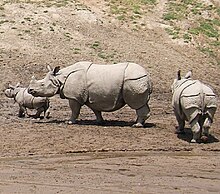| This article needs additional citations for verification. Please help improve this article by adding citations to reliable sources. Unsourced material may be challenged and removed. Find sources: "Rhinoceros" genus – news · newspapers · books · scholar · JSTOR (April 2016) (Learn how and when to remove this message) |
| Rhinoceros Temporal range: Late Miocene-Recent 9–0 Ma PreꞒ Ꞓ O S D C P T J K Pg N | |
|---|---|

| |
| Indian rhinoceros (R. unicornis) | |
| Scientific classification | |
| Domain: | Eukaryota |
| Kingdom: | Animalia |
| Phylum: | Chordata |
| Class: | Mammalia |
| Order: | Perissodactyla |
| Family: | Rhinocerotidae |
| Tribe: | Rhinocerotini |
| Genus: | Rhinoceros Linnaeus, 1758 |
| Type species | |
| Rhinoceros unicornis Linnaeus, 1758 | |
| Species | |
Rhinoceros is a genus comprising one-horned rhinoceroses. This scientific name was proposed by Swedish taxonomist Carl Linnaeus in 1758. The genus contains two species, the Indian rhinoceros (Rhinoceros unicornis) and the Javan rhinoceros (Rhinoceros sondaicus). Although both members are threatened, the Javan rhinoceros is one of the most endangered large mammals in the world with only 60 individuals surviving in Java (Indonesia). The word 'rhinoceros' is of Greek origin meaning "nose-horn".
Etymology
The genus name Rhinoceros is a combination of the ancient Greek words ῥίς (rhis) meaning 'nose' and κέρας (keras) meaning 'horn of an animal'.
Classification
The genus Rhinoceros comprises:
- Indian rhinoceros (R. unicornis) Linnaeus, 1758 Indian subcontinent
- Javan rhinoceros (R. sondaicus) Desmarest, 1822 Southeast Asia
- †R. sivalensis Falconer and Cautley, 1846 northern Indian subcontinent (Siwalik Hills) Pliocene-Early Pleistocene
- †R. platyrhinus Falconer and Cautley 1847 syn Punjabitherium Khan (1971) Upper Siwaliks, Indian subcontinent, Early Pleistocene to early Middle Pleistocene, India. Largest species in the genus.
- †R. sinensis Owen, 1870 Has been used as a wastebasket taxon used to refer to rhinoceros material from the Pleistocene of China, with various specimens belong to other Rhinoceros species, Dicerorhinus and Stephanorhinus, though it is possible that some remains attributed to Rhinoceros sinensis represents a valid and distinct species of Rhinoceros.
The earliest remains of the genus are known from the Late Miocene, represented by remains such as an indeterminate species found in deposits in Myanmar dating to around 8-9 million years ago.
The species "Rhinoceros" philippinensis from the early Middle Pleistocene of the Philippines and "Rhinoceros" sinensis hayasakai from the Early-Middle Pleistocene of Taiwan have been transferred to Nesorhinus, which appears to be closely related to Rhinoceros. While Rhinoceros fusuiensis Yan et al. 2014 from the Early Pleistocene of South China has been transferred to Dicerorhinus.
Relationships among Late Pleistocene and modern rhinoceros genera, based on nuclear DNA, after Liu et al, 2021:
| |||||||||||||||||||||||||||||||||||||||||||
Bayesian morphological phylogeny after Pandolfi, 2023 Note: This excludes living African rhinoceros species.
| ||||||||||||||||||||||||||||||||||||||||||||||||||||||||||||||||||||||||||||||||||||||||||||||||||||||||||||||||||||||||||||||||||
References
- ^ Linnæus, C. (1758). "Rhinoceros unicornis". Caroli Linnæi Systema naturæ per regna tria naturæ, secundum classes, ordines, genera, species, cum characteribus, differentiis, synonymis, locis. Holmiae: Salvius. p. 56.
- Liddell, H. G. & Scott, R. (1940). "ῥίς". A Greek-English Lexicon (Revised and augmented ed.). Oxford: Clarendon Press.
- Liddell, H. G. & Scott, R. (1940). "κέρᾳ". A Greek-English Lexicon (Revised and augmented ed.). Oxford: Clarendon Press.
- Desmarest, A. G. (1822). "Rhinocéros des Îles de La Sonde". Mammalogie, ou, Description des espèces de mammifères. Vol. 2. Paris: Mme Agasse. pp. 399–400.
- ^ Pandolfi, Luca; Maiorino, Leonardo (2016-02-06). "Reassessment of the largest Pleistocene rhinocerotine Rhinoceros platyrhinus (Mammalia, Rhinocerotidae) from the Upper Siwaliks (Siwalik Hills, India)" (PDF). Journal of Vertebrate Paleontology. 36 (2): e1071266. Bibcode:2016JVPal..36E1266P. doi:10.1080/02724634.2015.1071266. ISSN 0272-4634. S2CID 86893957.
- Schepartz, L. A.; Miller-Antonio, S. (2010). "Taphonomy, life history, and human exploitation of Rhinoceros sinensis at the Middle Pleistocene site of Panxian Dadong, Guizhou, China". International Journal of Osteoarchaeology. 20 (3): 253–268. doi:10.1002/oa.1025.
- Antoine, Pierre-Olivier (March 2012). "Pleistocene and Holocene rhinocerotids (Mammalia, Perissodactyla) from the Indochinese Peninsula". Comptes Rendus Palevol. 11 (2–3): 159–168. Bibcode:2012CRPal..11..159A. doi:10.1016/j.crpv.2011.03.002.
- Tong, Hao-wen (November 2012). "Evolution of the non-Coelodonta dicerorhine lineage in China". Comptes Rendus Palevol. 11 (8): 555–562. Bibcode:2012CRPal..11..555T. doi:10.1016/j.crpv.2012.06.002.
- Longuet, Morgane; Zin-Maung-Maung-Thein; Thaung-Htike; Man-Thit-Nyein; Takai, Masanaru (2024-08-02). "New fossil remains of Rhinocerotidae (Perissodactyla) from the early Late Miocene Tebingan area, central Myanmar". Historical Biology. 36 (8): 1468–1481. doi:10.1080/08912963.2023.2218873. ISSN 0891-2963.
- ^ Antoine, P.-O.; Reyes, M. C.; Amano, N.; Bautista, A. P.; Chang, C.-H.; Claude, J.; De Vos, J.; Ingicco, T. (2021). "A new rhinoceros clade from the Pleistocene of Asia sheds light on mammal dispersals to the Philippines". Zoological Journal of the Linnean Society. 194 (2): 416–430. doi:10.1093/zoolinnean/zlab009.
- Yan, Yaling; Wang, Yuan; Jin, Changzhu; Mead, Jim I. (December 2014). "New remains of Rhinoceros (Rhinocerotidae, Perissodactyla, Mammalia) associated with Gigantopithecus blacki from the Early Pleistocene Yanliang Cave, Fusui, South China". Quaternary International. 354: 110–121. Bibcode:2014QuInt.354..110Y. doi:10.1016/j.quaint.2014.01.004.
- Pandolfi, Luca (2023-01-19). "Reassessing the phylogeny of Quaternary Eurasian Rhinocerotidae". Journal of Quaternary Science. 38 (3): 291–294. Bibcode:2023JQS....38..291P. doi:10.1002/jqs.3496. hdl:11563/163194. ISSN 0267-8179. S2CID 256167036.
- Liu, Shanlin; Westbury, Michael V.; Dussex, Nicolas; Mitchell, Kieren J.; Sinding, Mikkel-Holger S.; Heintzman, Peter D.; Duchêne, David A.; Kapp, Joshua D.; von Seth, Johanna; Heiniger, Holly; Sánchez-Barreiro, Fátima (16 September 2021). "Ancient and modern genomes unravel the evolutionary history of the rhinoceros family". Cell. 184 (19): 4874–4885.e16. doi:10.1016/j.cell.2021.07.032. hdl:10230/48693. PMID 34433011. S2CID 237273079.
- Pandolfi, Luca (April 2023). "Reassessing the phylogeny of Quaternary Eurasian Rhinocerotidae". Journal of Quaternary Science. 38 (3): 291–294. Bibcode:2023JQS....38..291P. doi:10.1002/jqs.3496. hdl:11563/163194. ISSN 0267-8179.
External links
| Extant Perissodactyla (Odd-toed ungulates) species by suborder | |||||||||||||||||
|---|---|---|---|---|---|---|---|---|---|---|---|---|---|---|---|---|---|
| |||||||||||||||||
| |||||||||||||||||
| |||||||||||||||||
| Taxon identifiers | |
|---|---|
| Rhinoceros |
|
This article about an odd-toed ungulate is a stub. You can help Misplaced Pages by expanding it. |








